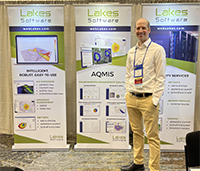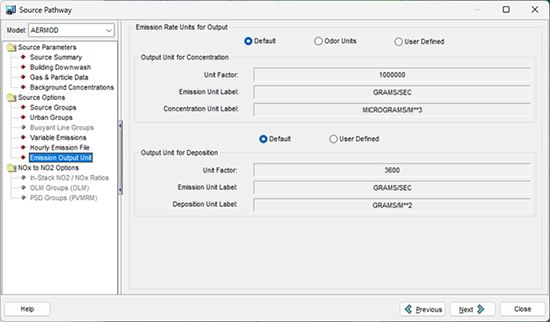Compliance Corner: Navigating the Regulatory Realm |
|
Update: 2025 Regional/State/Local Modelers Workshop
As announced last month, the U.S. EPA will hold their 2025 Regional/State/Local Modelers (RSL) Workshop from July 8–10, 2025, at the Nashville Main Public Library in Nashville, Tennessee.
It has been confirmed that stakeholders will now have the opportunity to participate virtually on the afternoon of Tuesday, July 8th. The 2025 RSL Dispersion Modelers' Workshop is otherwise limited to co-regulatory air permitting agencies.
Following the workshop, presentation slides will be made available on the SCRAM website.
|
|
Spring 2025 Conference Recap – Thank You! |
 |
|
Lakes Environmental was pleased to participate in two major events this spring — the TCEQ Environmental Trade Fair and Conference (June 2-3) and the A&WMA Annual Conference and Exhibition (June 9–12).
We want to extend a big thank you to everyone who visited our booths in San Antonio and Raleigh. It was a pleasure meeting each of you, sharing knowledge, and exploring how our tools can support your environmental goals.
|
We look forward to building on the conversations we had and are excited for the opportunities ahead — including reconnecting at the next A&WMA Conference in Austin, 2026!
|
|
Congratulations to our AERMOD View Draw Winner! |
As part of our participation in the A&WMA Annual Conference and Exhibition and the TCEQ Environmental Trade Fair and Conference, Lakes Environmental held a draw for a free 1-year license of our AERMOD View software.
We’re pleased to announce our winner:
- Citlalli Ordaz of Scout Energy
Congratulations Citlalli! We hope you enjoy using AERMOD View and look forward to supporting your modeling work.
|
|
Online AERMOD Training Course – Aug 5-6, 2025 |
 |
Register today for our next available 2-day online AERMOD course taking place on August 5 and 6, 2025 from 8:30am to 5:00pm (Central Time – Chicago, USA).
Register today!
Note: Due to the immense popularity of our online courses and small class sizes, we recommend registering and making payment as soon as possible to reserve your spot.
|
|
Online CALPUFF Training Course – Sep 16-17, 2025 |
 |
Enhance your air dispersion modeling skills by registering for our comprehensive 2-day online CALPUFF training course taking place on September 16 and 17, 2025 from 8:30am to 5:00pm (Central Time – Chicago).
Led by our expert instructors, this course offers in-depth instruction and hands-on exercises designed to help you effectively apply the CALPUFF modeling system in real-world scenarios.
Registration is now open – secure your spot today!
|
|
Lakes Environmental Closed for Canada Day Holiday |
Lakes Environmental will be closed on Tuesday, July 1, 2025 to observe the Canada Day holiday. Our Dallas office will remain open on this day. If you have any needs during that time, please e-mail us at support@webLakes.com and we will respond to your inquiry as soon as possible.
|
|
UPCOMING TRAINING COURSES |
|

|
MODELING TIP |
Customize AERMOD’s Output Units |
|
The AERMOD model features default units for emission inputs and concentration or deposition outputs. Emissions are presented as grams per second (g/s), and concentrations are calculated as micrograms per cubic meter (µg/m3). However, there may come a time when these default units need to be changed to better represent project data. This change can be easily made via the Source Pathway options.
Under the Source Pathway, look under Source Options and select the Emission Output Unit settings.

To enable custom units, select the User Defined radio button. The user can then supply their own values for each of the three fields:
- Unit Factor: The factor used to convert the emission rate input units to the output units. The default factor of 1000000 is used to get micrograms as output from the input of grams.
- Emission Unit Label: The label applied to the emission unit. This may be up to 40 characters in length.
- Concentration Unit Label: The output unit label. This may be up to 40 characters in length.
As shown above, custom units can also be applied to deposition calculations.
An example of where unit label adjustments can improve data readability is when the default units produce numeric values that are too large or too small for the model to accurately write. For example, very low emissions for a given source (e.g., 1E-6 g/s) may result in concentrations that are too small for the model to write (<1E-5 µg/m3). In this situation, you could:
- Modify the unit factor to 1000
- Reduce the magnitude of the Emission Unit Label to MICROGRAMS/SEC
- Write the Concentration Unit Label as NANOGRAMS/M**3
- Change the input emissions value on the Sources Input dialog to reflect the new unit
With this modification, the output values will have greater precision making the contour plots easier to read.
|
|

|
ENVIRONMENTAL NEWS ARTICLES |
A Haze Over North America |
June 4, 2025 - More than 180 wildland fires burned across Canada on June 1, 2025, continuing what has been an active fire year so far. Some of the fires produced plumes so thick and widespread they were easily visible from a vantage point in space well beyond that of the Moon.
Read more → |
|
Researchers Use Deep Learning to Predict Flooding This Hurricane Season |
June 4, 2025 - The 2025 hurricane season officially begins on June 1, and it's forecast to be more active than ever, with potentially devastating storms whose heavy rainfall and powerful storm surges cause dangerous coastal flooding.
Read more → |
|
|
|
LAKES SOFTWARE GROUP OF COMPANIES
|
 |
1-170 Columbia St. W.
Waterloo, ON N2L 3L3
View Online
This newsletter contains information gleaned from various sources on the web, with complete links
to the sources cited. Organizations cited are in no way affiliated with Lakes Environmental Software.
For more information, please visit our web site at: www.webLakes.com.
All comments and suggestions are welcome. You can e-mail us at: support@webLakes.com.
Privacy Policy |
|
| | | | |
